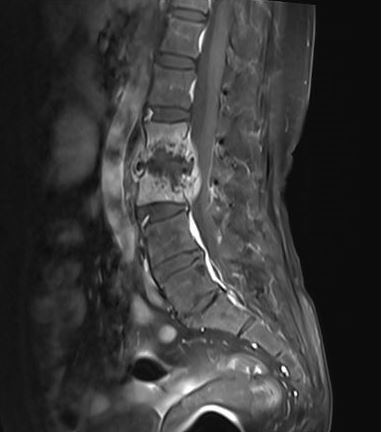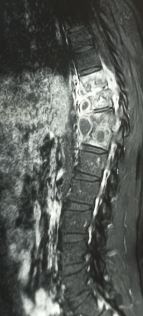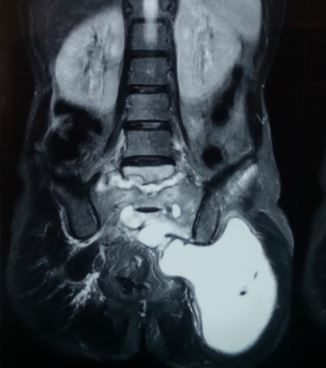[1]
Tuli SM. Historical aspects of Pott's disease (spinal tuberculosis) management. European spine journal : official publication of the European Spine Society, the European Spinal Deformity Society, and the European Section of the Cervical Spine Research Society. 2013 Jun:22 Suppl 4(Suppl 4):529-38. doi: 10.1007/s00586-012-2388-7. Epub 2012 Jul 17
[PubMed PMID: 22802129]
[2]
Dobson J. Percivall Pott. Annals of the Royal College of Surgeons of England. 1972 Jan:50(1):54-65
[PubMed PMID: 4550865]
[3]
Oettinger T, Jørgensen M, Ladefoged A, Hasløv K, Andersen P. Development of the Mycobacterium bovis BCG vaccine: review of the historical and biochemical evidence for a genealogical tree. Tubercle and lung disease : the official journal of the International Union against Tuberculosis and Lung Disease. 1999:79(4):243-50
[PubMed PMID: 10692993]
[4]
McLain RF, Isada C. Spinal tuberculosis deserves a place on the radar screen. Cleveland Clinic journal of medicine. 2004 Jul:71(7):537-9, 543-9
[PubMed PMID: 15320363]
[5]
Arockiaraj J, Karthik R, Michael JS, Amritanand R, David KS, Krishnan V, Sundararaj GD. 'Need of the Hour': Early Diagnosis and Management of Multidrug Resistant Tuberculosis of the Spine: An Analysis of 30 Patients from a "High Multidrug Resistant Tuberculosis Burden" Country. Asian spine journal. 2019 Apr:13(2):265-271. doi: 10.31616/asj.2018.0073. Epub 2019 Jan 24
[PubMed PMID: 30669824]
[6]
Rajasekaran S, Soundararajan DCR, Shetty AP, Kanna RM. Spinal Tuberculosis: Current Concepts. Global spine journal. 2018 Dec:8(4 Suppl):96S-108S. doi: 10.1177/2192568218769053. Epub 2018 Dec 13
[PubMed PMID: 30574444]
[7]
Shetty AP, Viswanathan VK, Kanna RM, Shanmuganathan R. Tubercular spondylodiscitis in elderly is a more severe disease: a report of 66 consecutive patients. European spine journal : official publication of the European Spine Society, the European Spinal Deformity Society, and the European Section of the Cervical Spine Research Society. 2017 Dec:26(12):3178-3186. doi: 10.1007/s00586-017-5157-9. Epub 2017 Jun 7
[PubMed PMID: 28593383]
[8]
Jain AK, Dhammi IK. Tuberculosis of the spine: a review. Clinical orthopaedics and related research. 2007 Jul:460():39-49
[PubMed PMID: 17438468]
[9]
Rasouli MR, Mirkoohi M, Vaccaro AR, Yarandi KK, Rahimi-Movaghar V. Spinal tuberculosis: diagnosis and management. Asian spine journal. 2012 Dec:6(4):294-308. doi: 10.4184/asj.2012.6.4.294. Epub 2012 Dec 14
[PubMed PMID: 23275816]
[10]
Jain AK. Tuberculosis of spine: Research evidence to treatment guidelines. Indian journal of orthopaedics. 2016 Jan-Feb:50(1):3-9. doi: 10.4103/0019-5413.173518. Epub
[PubMed PMID: 26955172]
[11]
Kulchavenya E. Extrapulmonary tuberculosis: are statistical reports accurate? Therapeutic advances in infectious disease. 2014 Apr:2(2):61-70. doi: 10.1177/2049936114528173. Epub
[PubMed PMID: 25165556]
Level 3 (low-level) evidence
[12]
Glaziou P, Floyd K, Raviglione MC. Global Epidemiology of Tuberculosis. Seminars in respiratory and critical care medicine. 2018 Jun:39(3):271-285. doi: 10.1055/s-0038-1651492. Epub 2018 Aug 2
[PubMed PMID: 30071543]
[13]
Goni V, Thapa BR, Vyas S, Gopinathan NR, Rajan Manoharan S, Krishnan V. Bilateral psoas abscess: atypical presentation of spinal tuberculosis. Archives of Iranian medicine. 2012 Apr:15(4):253-6
[PubMed PMID: 22424047]
[14]
Rajasekaran S, Kanna RM, Shetty AP. Pathophysiology and Treatment of Spinal Tuberculosis. JBJS reviews. 2014 Sep 23:2(9):. pii: e4. doi: 10.2106/JBJS.RVW.M.00130. Epub
[PubMed PMID: 27490153]
[15]
Ansari S, Amanullah MF, Ahmad K, Rauniyar RK. Pott's Spine: Diagnostic Imaging Modalities and Technology Advancements. North American journal of medical sciences. 2013 Jul:5(7):404-11. doi: 10.4103/1947-2714.115775. Epub
[PubMed PMID: 24020048]
[16]
Su SH, Tsai WC, Lin CY, Lin WR, Chen TC, Lu PL, Huang PM, Tsai JR, Wang YL, Feng MC, Wang TP, Chen YH. Clinical features and outcomes of spinal tuberculosis in southern Taiwan. Journal of microbiology, immunology, and infection = Wei mian yu gan ran za zhi. 2010 Aug:43(4):291-300. doi: 10.1016/S1684-1182(10)60046-1. Epub
[PubMed PMID: 20688289]
[17]
Hayes AJ, Choksey M, Barnes N, Sparrow OC. Spinal tuberculosis in developed countries: difficulties in diagnosis. Journal of the Royal College of Surgeons of Edinburgh. 1996 Jun:41(3):192-6
[PubMed PMID: 8763187]
[18]
Faure E, Souilamas R, Riquet M, Chehab A, Le Pimpec-Barthes F, Manac'h D, Debesse B. Cold abscess of the chest wall: a surgical entity? The Annals of thoracic surgery. 1998 Oct:66(4):1174-8
[PubMed PMID: 9800802]
[19]
Rajasekaran S, Shanmugasundaram TK. Prediction of the angle of gibbus deformity in tuberculosis of the spine. The Journal of bone and joint surgery. American volume. 1987 Apr:69(4):503-9
[PubMed PMID: 3571308]
[20]
Jain AK, Aggarwal PK, Arora A, Singh S. Behaviour of the kyphotic angle in spinal tuberculosis. International orthopaedics. 2004 Apr:28(2):110-4
[PubMed PMID: 15224169]
[21]
Hodgson AR, Skinsnes OK, Leong CY. The pathogenesis of Pott's paraplegia. The Journal of bone and joint surgery. American volume. 1967 Sep:49(6):1147-56
[PubMed PMID: 6038860]
[22]
Subramani S, Shetty AP, Kanna RM, Shanmuganathan R. Ossified ligamentum flavum causing neurological deficit above the level of post-tuberculous kyphotic deformity. Journal of clinical orthopaedics and trauma. 2017 Apr-Jun:8(2):174-177. doi: 10.1016/j.jcot.2016.09.012. Epub 2016 Oct 19
[PubMed PMID: 28720997]
[23]
Frankel HL, Hancock DO, Hyslop G, Melzak J, Michaelis LS, Ungar GH, Vernon JD, Walsh JJ. The value of postural reduction in the initial management of closed injuries of the spine with paraplegia and tetraplegia. I. Paraplegia. 1969 Nov:7(3):179-92
[PubMed PMID: 5360915]
[24]
Jain AK, Sinha S. Evaluation of systems of grading of neurological deficit in tuberculosis of spine. Spinal cord. 2005 Jun:43(6):375-80
[PubMed PMID: 15685259]
[25]
Jain AK, Kumar J. Tuberculosis of spine: neurological deficit. European spine journal : official publication of the European Spine Society, the European Spinal Deformity Society, and the European Section of the Cervical Spine Research Society. 2013 Jun:22 Suppl 4(Suppl 4):624-33. doi: 10.1007/s00586-012-2335-7. Epub 2012 May 8
[PubMed PMID: 22565802]
[26]
Rajasekaran S. The natural history of post-tubercular kyphosis in children. Radiological signs which predict late increase in deformity. The Journal of bone and joint surgery. British volume. 2001 Sep:83(7):954-62
[PubMed PMID: 11603534]
[27]
Rajasekaran S. Buckling collapse of the spine in childhood spinal tuberculosis. Clinical orthopaedics and related research. 2007 Jul:460():86-92
[PubMed PMID: 17471103]
[28]
Pande KC, Babhulkar SS. Atypical spinal tuberculosis. Clinical orthopaedics and related research. 2002 May:(398):67-74
[PubMed PMID: 11964633]
[29]
Dharmalingam M. Tuberculosis of the spine-the Sabah experience. Epidemiology, treatment and results. Tuberculosis (Edinburgh, Scotland). 2004:84(1-2):24-8
[PubMed PMID: 14670343]
[30]
Sinan T, Al-Khawari H, Ismail M, Ben-Nakhi A, Sheikh M. Spinal tuberculosis: CT and MRI feature. Annals of Saudi medicine. 2004 Nov-Dec:24(6):437-41
[PubMed PMID: 15646161]
[31]
Desai SS. Early diagnosis of spinal tuberculosis by MRI. The Journal of bone and joint surgery. British volume. 1994 Nov:76(6):863-9
[PubMed PMID: 7983108]
[32]
Adapon BD, Legada BD Jr, Lim EV, Silao JV Jr, Dalmacio-Cruz A. CT-guided closed biopsy of the spine. Journal of computer assisted tomography. 1981 Feb:5(1):73-8
[PubMed PMID: 7240501]
[33]
Kim NH, Lee HM, Suh JS. Magnetic resonance imaging for the diagnosis of tuberculous spondylitis. Spine. 1994 Nov 1:19(21):2451-5
[PubMed PMID: 7846600]
[34]
Kaila R, Malhi AM, Mahmood B, Saifuddin A. The incidence of multiple level noncontiguous vertebral tuberculosis detected using whole spine MRI. Journal of spinal disorders & techniques. 2007 Feb:20(1):78-81
[PubMed PMID: 17285057]
[35]
Gouliamos AD, Kehagias DT, Lahanis S, Athanassopoulou AA, Moulopoulou ES, Kalovidouris AA, Trakadas SJ, Vlahos LJ. MR imaging of tuberculous vertebral osteomyelitis: pictorial review. European radiology. 2001:11(4):575-9
[PubMed PMID: 11354749]
[36]
Vorster M, Sathekge MM, Bomanji J. Advances in imaging of tuberculosis: the role of ¹⁸F-FDG PET and PET/CT. Current opinion in pulmonary medicine. 2014 May:20(3):287-93. doi: 10.1097/MCP.0000000000000043. Epub
[PubMed PMID: 24614238]
Level 3 (low-level) evidence
[37]
Guo LX, Ma YZ, Li HW, Xue HB, Peng W, Luo XB. [Variety of ESR and C-reactive protein levels during perioperative period in spinal tuberculosis]. Zhongguo gu shang = China journal of orthopaedics and traumatology. 2010 Mar:23(3):200-2
[PubMed PMID: 20415078]
[38]
Jain AK, Jena SK, Singh MP, Dhammi IK, Ramachadran VG, Dev G. Evaluation of clinico-radiological, bacteriological, serological, molecular and histological diagnosis of osteoarticular tuberculosis. Indian journal of orthopaedics. 2008 Apr:42(2):173-7. doi: 10.4103/0019-5413.40253. Epub
[PubMed PMID: 19826523]
[39]
Chen CH, Chen YM, Lee CW, Chang YJ, Cheng CY, Hung JK. Early diagnosis of spinal tuberculosis. Journal of the Formosan Medical Association = Taiwan yi zhi. 2016 Oct:115(10):825-836. doi: 10.1016/j.jfma.2016.07.001. Epub 2016 Aug 10
[PubMed PMID: 27522334]
[40]
Cruciani M, Scarparo C, Malena M, Bosco O, Serpelloni G, Mengoli C. Meta-analysis of BACTEC MGIT 960 and BACTEC 460 TB, with or without solid media, for detection of mycobacteria. Journal of clinical microbiology. 2004 May:42(5):2321-5
[PubMed PMID: 15131224]
Level 1 (high-level) evidence
[41]
Maynard-Smith L, Larke N, Peters JA, Lawn SD. Diagnostic accuracy of the Xpert MTB/RIF assay for extrapulmonary and pulmonary tuberculosis when testing non-respiratory samples: a systematic review. BMC infectious diseases. 2014 Dec 31:14():709. doi: 10.1186/s12879-014-0709-7. Epub 2014 Dec 31
[PubMed PMID: 25599808]
Level 1 (high-level) evidence
[42]
Lifeso RM, Weaver P, Harder EH. Tuberculous spondylitis in adults. The Journal of bone and joint surgery. American volume. 1985 Dec:67(9):1405-13
[PubMed PMID: 4077912]
[43]
Alothman A, Memish ZA, Awada A, Al-Mahmood S, Al-Sadoon S, Rahman MM, Khan MY. Tuberculous spondylitis: analysis of 69 cases from Saudi Arabia. Spine. 2001 Dec 15:26(24):E565-70
[PubMed PMID: 11740373]
Level 3 (low-level) evidence
[44]
Kumar R, Das RK, Mahapatra AK. Role of interferon gamma release assay in the diagnosis of Pott disease. Journal of neurosurgery. Spine. 2010 May:12(5):462-6. doi: 10.3171/2009.10.SPINE093. Epub
[PubMed PMID: 20433293]
[45]
Brodie D, Lederer DJ, Gallardo JS, Trivedi SH, Burzynski JN, Schluger NW. Use of an interferon-gamma release assay to diagnose latent tuberculosis infection in foreign-born patients. Chest. 2008 Apr:133(4):869-74. doi: 10.1378/chest.07-1815. Epub 2008 Jan 15
[PubMed PMID: 18198254]
[46]
Rajasekaran S, Khandelwal G. Drug therapy in spinal tuberculosis. European spine journal : official publication of the European Spine Society, the European Spinal Deformity Society, and the European Section of the Cervical Spine Research Society. 2013 Jun:22 Suppl 4(Suppl 4):587-93. doi: 10.1007/s00586-012-2337-5. Epub 2012 May 12
[PubMed PMID: 22581190]
[47]
Zhang Z, Luo F, Zhou Q, Dai F, Sun D, Xu J. The outcomes of chemotherapy only treatment on mild spinal tuberculosis. Journal of orthopaedic surgery and research. 2016 May 14:11(1):49. doi: 10.1186/s13018-016-0385-y. Epub 2016 May 14
[PubMed PMID: 27177692]
[48]
Bodapati PC, Vemula RCV, Mohammad AA, Mohan A. Outcome and management of spinal tuberculosis according to severity at a tertiary referral center. Asian journal of neurosurgery. 2017 Jul-Sep:12(3):441-446. doi: 10.4103/1793-5482.180924. Epub
[PubMed PMID: 28761522]
[49]
Jawahar MS. Current trends in chemotherapy of tuberculosis. The Indian journal of medical research. 2004 Oct:120(4):398-417
[PubMed PMID: 15520489]
[50]
Ali A, Musbahi O, White VLC, Montgomery AS. Spinal Tuberculosis: A Literature Review. JBJS reviews. 2019 Jan:7(1):e9. doi: 10.2106/JBJS.RVW.18.00035. Epub
[PubMed PMID: 30694877]
[51]
Cox HS, Morrow M, Deutschmann PW. Long term efficacy of DOTS regimens for tuberculosis: systematic review. BMJ (Clinical research ed.). 2008 Mar 1:336(7642):484-7. doi: 10.1136/bmj.39463.640787.BE. Epub 2008 Feb 4
[PubMed PMID: 18250104]
Level 1 (high-level) evidence
[52]
Valsalan R, Purushothaman R, Raveendran M, Zacharia B, Surendran S. Efficacy of directly observed treatment short-course intermittent regimen in spinal tuberculosis. Indian journal of orthopaedics. 2012 Mar:46(2):138-44. doi: 10.4103/0019-5413.93673. Epub
[PubMed PMID: 22448050]
[53]
Gandhi NR, Moll A, Sturm AW, Pawinski R, Govender T, Lalloo U, Zeller K, Andrews J, Friedland G. Extensively drug-resistant tuberculosis as a cause of death in patients co-infected with tuberculosis and HIV in a rural area of South Africa. Lancet (London, England). 2006 Nov 4:368(9547):1575-80
[PubMed PMID: 17084757]
[54]
Pawar UM, Kundnani V, Agashe V, Nene A, Nene A. Multidrug-resistant tuberculosis of the spine--is it the beginning of the end? A study of twenty-five culture proven multidrug-resistant tuberculosis spine patients. Spine. 2009 Oct 15:34(22):E806-10. doi: 10.1097/BRS.0b013e3181af7797. Epub
[PubMed PMID: 19829244]
[55]
Velayati AA, Masjedi MR, Farnia P, Tabarsi P, Ghanavi J, ZiaZarifi AH, Hoffner SE. Emergence of new forms of totally drug-resistant tuberculosis bacilli: super extensively drug-resistant tuberculosis or totally drug-resistant strains in iran. Chest. 2009 Aug:136(2):420-425. doi: 10.1378/chest.08-2427. Epub 2009 Apr 6
[PubMed PMID: 19349380]
[56]
HODGSON AR, STOCK FE. Anterior spinal fusion a preliminary communication on the radical treatment of Pott's disease and Pott's paraplegia. The British journal of surgery. 1956 Nov:44(185):266-75
[PubMed PMID: 13383153]
[57]
. A controlled trial of six-month and nine-month regimens of chemotherapy in patients undergoing radical surgery for tuberculosis of the spine in Hong Kong. Tenth report of the Medical Research Council Working Party on Tuberculosis of the Spine. Tubercle. 1986 Dec:67(4):243-59
[PubMed PMID: 2889281]
[58]
Tuli SM. Severe kyphotic deformity in tuberculosis of the spine. International orthopaedics. 1995:19(5):327-31
[PubMed PMID: 8567145]
[59]
Govender S, Kumar KP. Cortical allografts in spinal tuberculosis. International orthopaedics. 2003:27(4):244-8
[PubMed PMID: 12715238]
[60]
Benli IT, Kaya A, Acaroğlu E. Anterior instrumentation in tuberculous spondylitis: is it effective and safe? Clinical orthopaedics and related research. 2007 Jul:460():108-16
[PubMed PMID: 17452918]
[61]
Christodoulou AG, Givissis P, Karataglis D, Symeonidis PD, Pournaras J. Treatment of tuberculous spondylitis with anterior stabilization and titanium cage. Clinical orthopaedics and related research. 2006 Mar:444():60-5
[PubMed PMID: 16523128]
[62]
Chen YC, Chang MC, Wang ST, Yu WK, Liu CL, Chen TH. One-stage posterior surgery for treatment of advanced spinal tuberculosis. Journal of the Chinese Medical Association : JCMA. 2003 Jul:66(7):411-7
[PubMed PMID: 14509403]
[63]
Lee SH, Sung JK, Park YM. Single-stage transpedicular decompression and posterior instrumentation in treatment of thoracic and thoracolumbar spinal tuberculosis: a retrospective case series. Journal of spinal disorders & techniques. 2006 Dec:19(8):595-602
[PubMed PMID: 17146304]
Level 2 (mid-level) evidence
[64]
Zhong W, Xiong G, Wang B, Lu C, Dai Z, Lv G. Surgical management for thoracic spinal tuberculosis posterior only versus anterior video-assisted thoracoscopic surgery. PloS one. 2015:10(3):e0119759. doi: 10.1371/journal.pone.0119759. Epub 2015 Mar 17
[PubMed PMID: 25781165]
[65]
Jain AK, Dhammi IK, Prashad B, Sinha S, Mishra P. Simultaneous anterior decompression and posterior instrumentation of the tuberculous spine using an anterolateral extrapleural approach. The Journal of bone and joint surgery. British volume. 2008 Nov:90(11):1477-81. doi: 10.1302/0301-620X.90B11.20972. Epub
[PubMed PMID: 18978269]
[66]
Moon MS. Tuberculosis of spine: current views in diagnosis and management. Asian spine journal. 2014 Feb:8(1):97-111. doi: 10.4184/asj.2014.8.1.97. Epub 2014 Feb 6
[PubMed PMID: 24596613]
[67]
Chen WJ, Wu CC, Jung CH, Chen LH, Niu CC, Lai PL. Combined anterior and posterior surgeries in the treatment of spinal tuberculous spondylitis. Clinical orthopaedics and related research. 2002 May:(398):50-9
[PubMed PMID: 11964631]
[68]
Talu U, Gogus A, Ozturk C, Hamzaoglu A, Domanic U. The role of posterior instrumentation and fusion after anterior radical debridement and fusion in the surgical treatment of spinal tuberculosis: experience of 127 cases. Journal of spinal disorders & techniques. 2006 Dec:19(8):554-9
[PubMed PMID: 17146297]
Level 3 (low-level) evidence
[69]
Jayaswal A, Upendra B, Ahmed A, Chowdhury B, Kumar A. Video-assisted thoracoscopic anterior surgery for tuberculous spondylitis. Clinical orthopaedics and related research. 2007 Jul:460():100-7
[PubMed PMID: 17471105]
[70]
Kandwal P, G V, Jayaswal A. Management of Tuberculous Infection of the Spine. Asian spine journal. 2016 Aug:10(4):792-800. doi: 10.4184/asj.2016.10.4.792. Epub 2016 Aug 16
[PubMed PMID: 27559464]
[71]
Ito M, Sudo H, Abumi K, Kotani Y, Takahata M, Fujita M, Minami A. Minimally invasive surgical treatment for tuberculous spondylodiscitis. Minimally invasive neurosurgery : MIN. 2009 Oct:52(5-6):250-3. doi: 10.1055/s-0029-1220685. Epub 2010 Jan 14
[PubMed PMID: 20077368]
[72]
Rajasekaran S. Natural history of Pott's kyphosis. European spine journal : official publication of the European Spine Society, the European Spinal Deformity Society, and the European Section of the Cervical Spine Research Society. 2013 Jun:22 Suppl 4(Suppl 4):634-40. doi: 10.1007/s00586-012-2336-6. Epub 2012 May 15
[PubMed PMID: 22584918]
[73]
Grevitt M, Kamath V, Avadhani A, Rajasekaran S. Correction of thoracic kyphosis with Ponte osteotomy. European spine journal : official publication of the European Spine Society, the European Spinal Deformity Society, and the European Section of the Cervical Spine Research Society. 2010 Feb:19(2):351-2. doi: 10.1007/s00586-010-1311-3. Epub
[PubMed PMID: 20135330]
[74]
Kalra KP, Dhar SB, Shetty G, Dhariwal Q. Pedicle subtraction osteotomy for rigid post-tuberculous kyphosis. The Journal of bone and joint surgery. British volume. 2006 Jul:88(7):925-7
[PubMed PMID: 16798997]
[75]
Rajasekaran S, Vijay K, Shetty AP. Single-stage closing-opening wedge osteotomy of spine to correct severe post-tubercular kyphotic deformities of the spine: a 3-year follow-up of 17 patients. European spine journal : official publication of the European Spine Society, the European Spinal Deformity Society, and the European Section of the Cervical Spine Research Society. 2010 Apr:19(4):583-92. doi: 10.1007/s00586-009-1234-z. Epub 2009 Dec 15
[PubMed PMID: 20013004]
[76]
Zheng B, Hao D, Guo H, He B. Anterior versus posterior surgical approach for lumbosacral tuberculosis. The Journal of international medical research. 2018 Jul:46(7):2569-2577. doi: 10.1177/0300060518764933. Epub 2018 Mar 27
[PubMed PMID: 29584540]
[77]
Kumar K. Spinal tuberculosis, natural history of disease, classifications and principles of management with historical perspective. European journal of orthopaedic surgery & traumatology : orthopedie traumatologie. 2016 Aug:26(6):551-8. doi: 10.1007/s00590-016-1811-x. Epub 2016 Jul 19
[PubMed PMID: 27435619]
Level 3 (low-level) evidence



